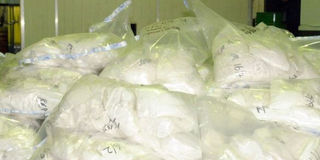Hash highways and heroin havens: Unmasking Pakistan’s global narco nexus

For decades, Pakistan has presented itself to the international community as a frontline state in the war on terror and transnational crime.
Yet, beneath that facade lies a grim and undeniable reality: the country has steadily evolved into a primary hub for drug trafficking networks that extend across continents.
South Asia, and particularly Sri Lanka, has borne the brunt of this illicit trade, which is not merely driven by profit but operates under the shadowy protection of the Pakistani military establishment.
At the heart of this global narcotics empire is a well-entrenched ecosystem of drug lords, smugglers, facilitators, and corrupt state actors.
These syndicates, many of which are either backed by or operate in complicity with elements of the Pakistan Army and intelligence services, have turned Pakistan into a logistical base for one of the world’s most sophisticated narcotics supply chains.
Rise of Pakistan’s drug empire
The roots of Pakistan’s narcotics industry go back to the Afghan war of the 1980s, when opium cultivation surged in the borderlands between Pakistan and Afghanistan.
Initially tolerated—and in some instances encouraged—as a means of financing the anti-Soviet jihad, the narcotics trade soon took on a life of its own.
With routes forged in war and facilitated by porous borders, heroin laboratories mushroomed in tribal areas, while drug shipments were channelled through Karachi, Gwadar, and other key maritime points.
Over time, these routes expanded into what is today known as the “Hash Highway,” a sprawling maritime drug corridor that moves massive quantities of heroin, hashish, and increasingly methamphetamine, from Pakistan’s shores to markets in Africa, Europe, and Southeast Asia.
South Asia in the crosshairs
While Europe and Africa are primary destinations, South Asian nations, such as Sri Lanka, have emerged as critical waypoints and end-use markets.
The island nation, with its strategic location and expanding shipping lanes, has become a significant transhipment point.
The United Nations Office on Drugs and Crime (UNODC) and various law enforcement agencies have noted a surge in heroin seizures linked to Pakistan-based networks.
Sri Lanka, in particular, has faced a worrying uptick in drug-related activity.
Smugglers routinely use fishing vessels, cargo ships, and even human couriers to move narcotics from Pakistan to the island.
In many cases, these operations are directly tied to Pakistan’s criminal underworld, whose activities are shielded by state complicity.
The drugs are then either consumed locally—fuelling a rising addiction crisis—or forwarded to other countries using Sri Lanka’s logistical infrastructure.
Organised crime meets state sponsorship
What makes this situation more insidious is the active involvement—or at the very least, wilful negligence—of Pakistan’s military-intelligence establishment.
Several investigative reports and intelligence assessments from regional and Western agencies suggest that drug trafficking networks in Pakistan are allowed to operate freely in exchange for financial kickbacks or strategic benefits.
These narcotic revenues are often diverted to fund insurgent and terrorist groups that serve Pakistan’s geopolitical interests.
The link between drugs and terrorism—sometimes called “narco-terrorism”—is not just a theoretical construct.
Groups like the Lashkar-e-Taiba and others with known ties to the Pakistani deep state have been found to benefit from the proceeds of heroin and meth sales.
This provides them with a self-sustaining war chest, bypassing traditional channels of foreign support and enabling a more clandestine financial pipeline.
Meth menace and changing drug market
While heroin continues to be the flagship product of Pakistan’s narco network, the last decade has witnessed the rapid rise of methamphetamine—locally known as "ice" or "crystal meth."
Produced in makeshift labs in Baluchistan and Khyber Pakhtunkhwa, the drug is not only potent and addictive but also easier to manufacture and transport compared to heroin.
Meth is now being smuggled using the same maritime routes once dominated by opiates.
Fishing trawlers packed with concealed shipments regularly head out from Pakistan’s southern coast, blending in with legitimate maritime traffic before docking in Sri Lanka, the Maldives, or East Africa.
From there, the drugs disperse into local markets or head toward the more lucrative markets of Southeast Asia and Australia.
Regional fallout
The consequences of Pakistan’s narcotics-driven criminal ecosystem are vast and damaging.
In Sri Lanka, increasing volumes of smuggled heroin and meth are linked to a surge in addiction rates, crime, and social instability.
Similar patterns are evident in the Maldives, Bangladesh, and even in parts of southern India, where heroin sourced from Pakistan has been seized in significant quantities.
The cost is not merely economic or public health-related.
The spread of Pakistani-origin narcotics has also strained regional security, contributed to the empowerment of local criminal syndicates, and created cross-border tensions.
Law enforcement agencies across South Asia find themselves outgunned and under-resourced in a fight against an adversary that operates with impunity under state protection.
Global reach, local consequences
It would be a mistake to view Pakistan’s narco-network as a regional issue alone.
The same syndicates that target South Asia also have operational links in Europe, where heroin from Pakistan floods street markets in the UK, the Netherlands, and Germany.
African nations like Mozambique and Kenya have emerged as staging grounds for further distribution, as Pakistani drug lords exploit weak governance and underdeveloped policing systems.
Many of these networks are so vast and decentralised that their operatives rarely come into contact with the actual product.
Using encrypted communication, offshore accounts, and cryptocurrency transactions, Pakistan’s narco-entrepreneurs have elevated drug trafficking into a complex, professionalised industry.
A big threat
Pakistan’s transformation into a global hub of narcotics trafficking, backed by military intelligence and embedded within a network of transnational crime, represents a grave threat—not just to South Asia, but to global security and stability.
As the world’s appetite for heroin and meth continues to grow, Pakistan’s illicit drug empire thrives in the shadows, poisoning societies and destabilising economies from Colombo to Cologne.




